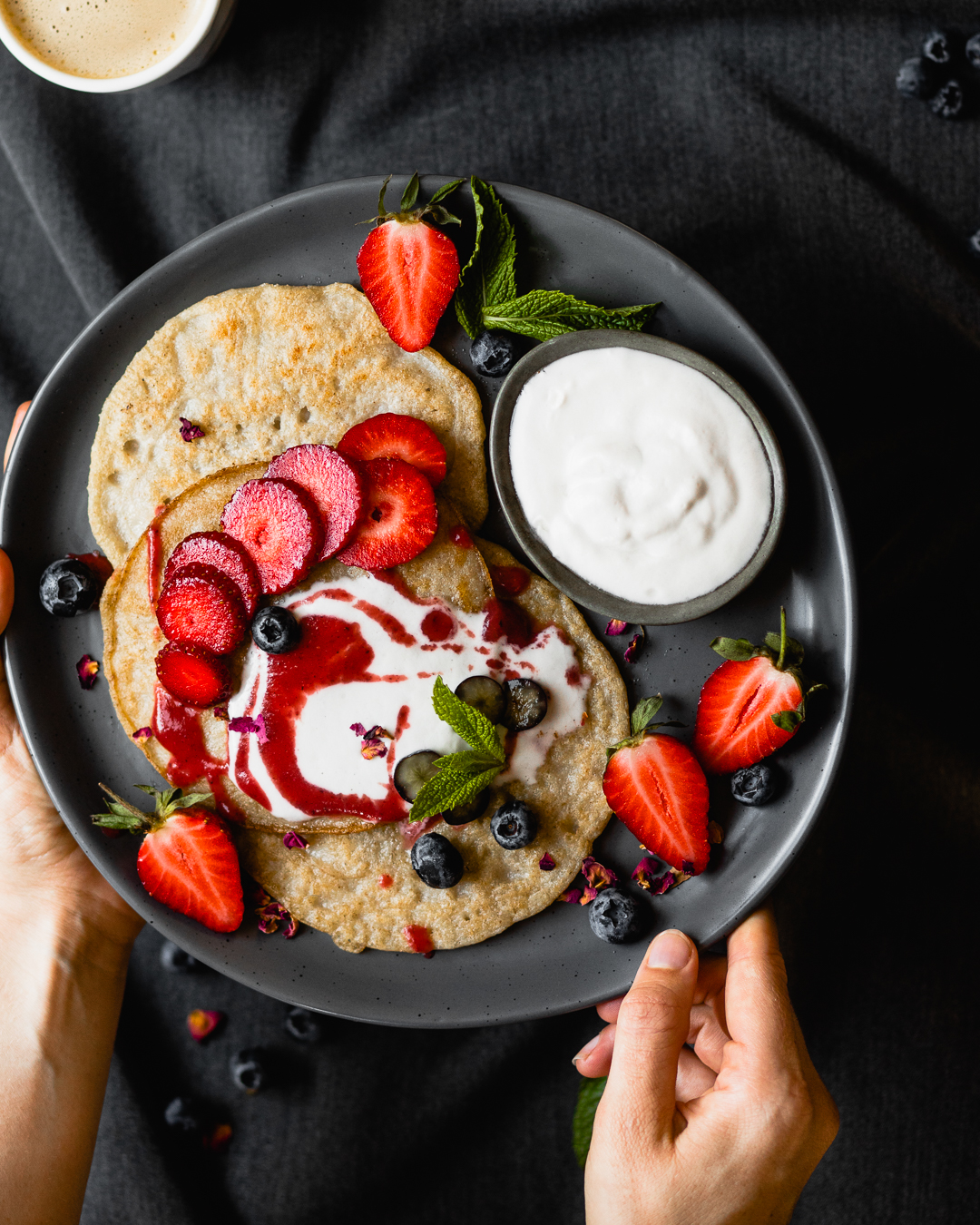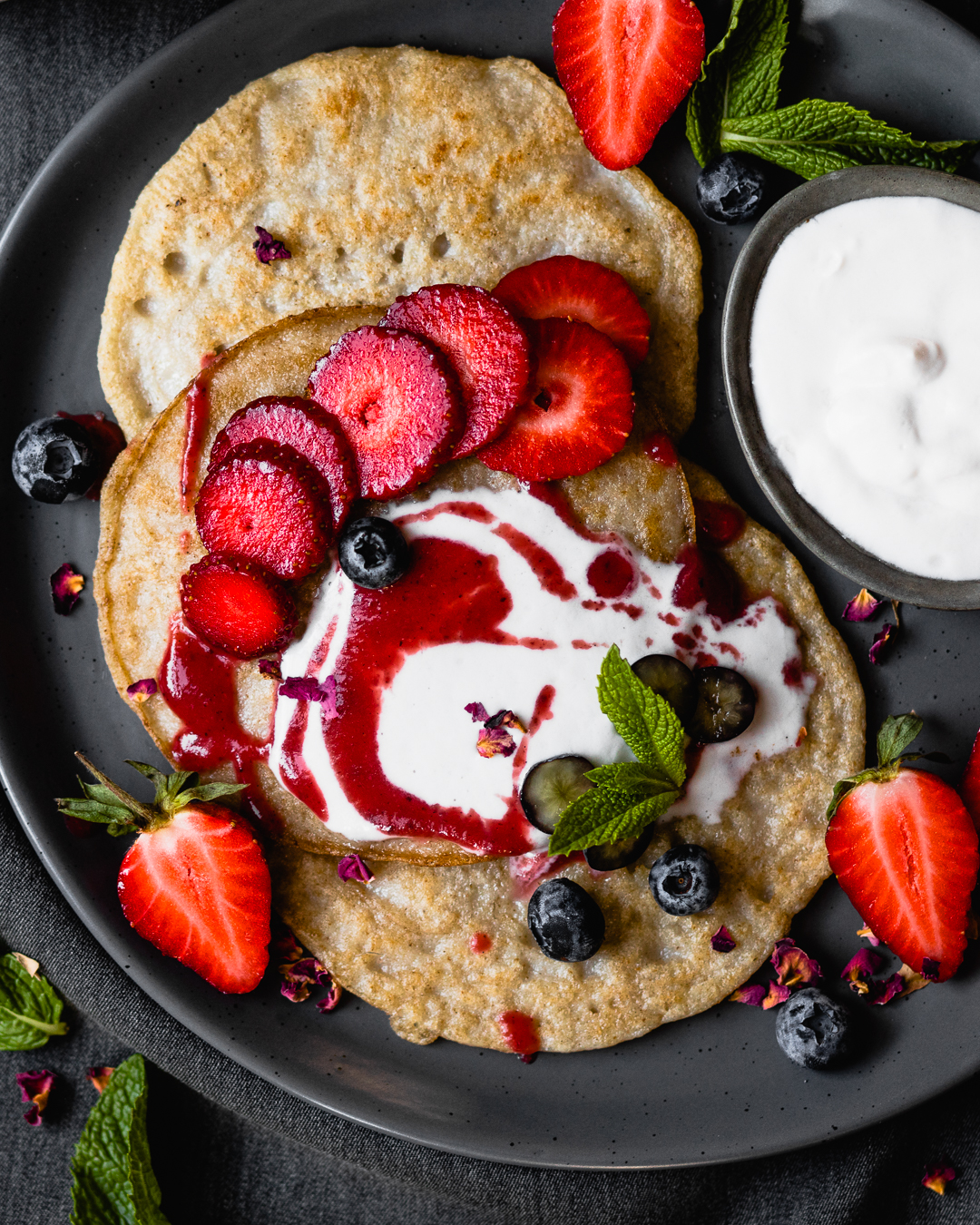4 Ingredient EGG-FREE (Fermented) Pancakes
Since I started avoiding eggs almost two years ago, I’ve seriously missed eating pancakes! And every time I made pancakes for breakfast for Roy to enjoy, I’ve also had serious FOMO every single time. This recipe was inspired by My New Roots, when I saw they had a pancake recipe that was egg-free and gluten free – a recipe I’ve been trying to tackle for years now – I had to give it a try. And I must say, with a couple of small tweaks, I’ve made it my own and am totally in love with the result.
I have to be totally honest with you, these pancakes/ wraps are nowhere near like the familiar wheat based pancakes you probably loved and ate growing up. They’re not made with wheat flour, or any flour for that matter so they don’t have that soft, light and fluffy texture that the gluten usually provides. They’re made from fermented buckwheat and rice! Because they have no gluten in them, they’re denser and chewier than normal pancakes and the edges crisp up beautifully, but this chewy texture and quality is something I really like. It sounds a little weird I know, but this is honestly a lifesaver if you’re like me and cannot eat eggs, or if you’re vegan and always have FOMO seeing other people eat pancakes.
Why Soak & Ferment The Grains?
Because this is how grains were traditionally prepared thousands of years ago to help reduce the not-so-great properties of grains and make them more bioavailable and easier to digest. Among these traditional methods are soaking, sprouting or fermenting (or a combination of all three). All grains contain phytic acid (an anti-nutrient) that can block the body’s absorption of minerals. Soaking the grains breaks down the outer layers that contain the phytic acid and enables the body to better digest grains and absorb nutrients. Adding fermentation to the mix reduces the harmful properties even more + the beneficial bacteria contained in the coconut water kefir begins to eat away the sugars in the grains, making it a lower carb option than if it wasn’t fermented. Obviously once the pancakes are cooked, the heat will destroy the probiotics in the pancakes. However the main reason I have chosen to ferment the grains is to improve the digestibility making it a lot more gut friendly, reduce the anti-nutrients making it more bioavailable and lower the carbohydrate content.
4 Main Ingredients
1 cup raw, organic buckwheat
1/2 cup raw, organic white rice
1 Tbsp psyllium husk
1 cup AYAM coconut cream
You will also need;
Pinch of salt
Filtered water
1/4 cup coconut water kefir (for the fermentation)
Butter/ ghee, coconut oil or olive oil for frying
Method
Add the rice and buckwheat to a clean glass jar with the salt and coconut water kefir. Now add the filtered water so it’s completely covering the grains. Close the lid and allow this to sit and ferment overnight or up to 24 hours.
Rinse the grains really well in fresh filtered water.
Add the soaked/ fermented and rinsed grains to a high powered blender or thermomix and blend on high with the coconut cream and the psyllium husk. Blend until its smooth and completely lump free.
Allow this to sit for 5 minutes to allow the liquid to absorb the psyllium husk and thicken. If it thickens too much, add some filtered water and re-blend until you reach your preferred consistency. You want the consistency to be pancake batter consistency. Don’t worry if you accidentally add too much water, just let it sit there for 5 minutes longer as it will continue to thicken/ absorb the liquid. If you want to make these into wraps, blend in a little more water so the consistency is a bit runnier.
Heat a frying pan on medium heat. Add your chosen fat and allow it to melt and coat the pan.
Add 2-3 Tbsp of the pancake batter to the frying pan and cook until golden brown. I found the pancakes went crispy when I fried them in butter and were still slightly soft and chewy on the inside. Please note they don’t go a dark golden brown, just a paler golden brown.
Continue this method of cooking for the remaining pancake batter.
If you want to keep them warm while you continue cooking the rest of the pancakes, you can pre-heat the oven and place the cooked pancakes onto a wire rack so the bottom doesn’t go soggy. Or just eat them straight away with a bit of salted butter for maximum enjoyment!
You can serve these as sweet or savoury pancakes or wraps. For the savoury version, keep scrolling for more tips.
Savoury Version Tips
Use the same ingredients and method as listed above, however for a boost of flavour, you can add in any of the following; a pinch of salt, pepper, garlic or onion powder, turmeric, chilli powder and even dried herbs
I have found making the batter a slightly runnier pancake consistency works best for the savoury wraps
They work really well as ‘taco’ wraps if you cook them all, then keep them in the fridge overnight (kind of batch cooking them). Then the next day either re-fry them, or re-heat them in the oven on a wire rack. Then choose your fillings. Doing it this way is fantastic for creating resistant starch and makes it a lot more gut friendly too.
I filled the below wraps with; super fresh bream, herbs, thinly sliced cucumber, fermented veggies, avocado, chilli, fermented mustard, spring onion and caramelised onion and garlic with a good drizzle of lemon juice on top.
Additional Notes
I have not tried this recipe with any other grains such as quinoa, amaranth etc.
I have not tried this recipe using other milks such as almond, macadamia etc.
If you end up making this recipe using a different grain (other than rice) or a different milk, please let me know if it’s a success :)






